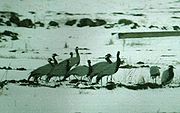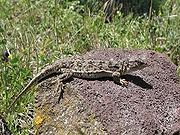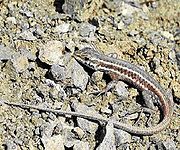
Sevan National Park
Encyclopedia
Sevan National Park in Armenia
was established in 1978 to protect Lake Sevan
and the surrounding areas. Sevan National Park falls under the jurisdiction of the Ministry of Nature Protection
, and is managed as a research center, which monitors the ecosystems, and undertakes various conservation measures. Licensed fishing on the lake is also regulated. Currently, Sevan National Park is one of two existing national parks in Armenia (see Dilijan National Park
).
, fox
, marten
, cat
, hare
, small rodents are usually mentioned.

 Sevan lake and its vicinities are rich in avifauna. Up to 267 bird species are registered in Sevan Basin. The existing avifauna can be grouped into podicipediformes, pelecaniformes, phoenicopteriformes, falconiformes, anseriformes, galliformes, gruiformes, charadriiformes, columbiformes, cuculiformes, strigiformes, caprimulgiformes, apodiformes, coraciiformes, piciformes, passeriformes. 39 species are included in the Red Book
Sevan lake and its vicinities are rich in avifauna. Up to 267 bird species are registered in Sevan Basin. The existing avifauna can be grouped into podicipediformes, pelecaniformes, phoenicopteriformes, falconiformes, anseriformes, galliformes, gruiformes, charadriiformes, columbiformes, cuculiformes, strigiformes, caprimulgiformes, apodiformes, coraciiformes, piciformes, passeriformes. 39 species are included in the Red Book
of Armenia. There is also an endemic species Armenian gull
(larus armenicus).

Bufo viridis Laurenti, Hyla arborea schelkownikowi, Rana ridibunda, Rana macrocnemis, Laudakia caucasia, Anguis Fragilis, Eremias arguta transcaucasica, Lacerta agilis brevicaudata, Lacerta strigata, Parvilacerta parva, Darevskia unsexualis, Darevskia valentini, Platiceps najadum, Hammerhois ravergieri, Coronella austriaca, Eirenis punctatolineatus, Natrix natrix, Natrix tesselata, Vipera (Pelias) eriwanensis.
(Salmo ischchan) and Sevan beghlu are included in the Red Book
of Armenia.
(Bern Convention).
Armenia
Armenia , officially the Republic of Armenia , is a landlocked mountainous country in the Caucasus region of Eurasia...
was established in 1978 to protect Lake Sevan
Lake Sevan
Lake Sevan is the largest lake in Armenia and the Caucasus region. It is one of the largest high-altitude lakes in the world.Lake Sevan is situated in the central part of the Republic of Armenia, inside the Gegharkunik Province, at the altitude of 1,900m above sea level...
and the surrounding areas. Sevan National Park falls under the jurisdiction of the Ministry of Nature Protection
Ministry of Nature Protection
Ministry of Nature Protection worked in Armenia since 1997 and still today, when the project "First National Report, Biodiversity Strategy and Action Plan to CBD" was implemented...
, and is managed as a research center, which monitors the ecosystems, and undertakes various conservation measures. Licensed fishing on the lake is also regulated. Currently, Sevan National Park is one of two existing national parks in Armenia (see Dilijan National Park
Dilijan National Park
Dilijan National Park, occupying 24,000 ha, is located in the North-Eastern part of the Republic of Armenia, in Tavush province . Dilijan National Park is well known for its forest landscapes, rich biodiversity, medicinal mineral water springs, natural and cultural monuments...
).
Mammals
Scientific knowledge about the mammals of the Sevan basin is quite poor and fragmental. Wolf, jackalJackal
Although the word jackal has been historically used to refer to many small- to medium-sized species of the wolf genus of mammals, Canis, today it most properly and commonly refers to three species: the black-backed jackal and the side-striped jackal of sub-Saharan Africa, and the golden jackal of...
, fox
Fox
Fox is a common name for many species of omnivorous mammals belonging to the Canidae family. Foxes are small to medium-sized canids , characterized by possessing a long narrow snout, and a bushy tail .Members of about 37 species are referred to as foxes, of which only 12 species actually belong to...
, marten
Marten
The martens constitute the genus Martes within the subfamily Mustelinae, in family Mustelidae.-Description:Martens are slender, agile animals, adapted to living in taigas, and are found in coniferous and northern deciduous forests across the northern hemisphere. They have bushy tails, and large...
, cat
Cat
The cat , also known as the domestic cat or housecat to distinguish it from other felids and felines, is a small, usually furry, domesticated, carnivorous mammal that is valued by humans for its companionship and for its ability to hunt vermin and household pests...
, hare
Hare
Hares and jackrabbits are leporids belonging to the genus Lepus. Hares less than one year old are called leverets. Four species commonly known as types of hare are classified outside of Lepus: the hispid hare , and three species known as red rock hares .Hares are very fast-moving...
, small rodents are usually mentioned.
Avifauna


Red Book
Red Book, Redbooks, Little Red Book or Big Red Book may refer to:- Political or ideological pamphlets :* The Little Red Book, the name commonly known in the West for the pocket-size edition of Quotations from Chairman Mao Tse-Tung...
of Armenia. There is also an endemic species Armenian gull
Armenian Gull
The Armenian Gull is a large gull found in the Caucasus and Middle East. It was formerly classified as a subspecies of the Herring Gull but is now generally considered to be a separate species although BirdLife International lumps it with the Yellow-legged Gull The Armenian Gull (Larus armenicus)...
(larus armenicus).

Herpetofauna
In the Masrik river valley, the following species of reptiles can be met:Bufo viridis Laurenti, Hyla arborea schelkownikowi, Rana ridibunda, Rana macrocnemis, Laudakia caucasia, Anguis Fragilis, Eremias arguta transcaucasica, Lacerta agilis brevicaudata, Lacerta strigata, Parvilacerta parva, Darevskia unsexualis, Darevskia valentini, Platiceps najadum, Hammerhois ravergieri, Coronella austriaca, Eirenis punctatolineatus, Natrix natrix, Natrix tesselata, Vipera (Pelias) eriwanensis.
Ichtyofauna
Masrik river and its tributaries flow in the proximity of the urban areas. The river is of great importance, since its a spowning place for such endemic species as Gegharkunik trout (Salmo ishchan gegarkuni), Sevan koghak (Capoeta capoeta sevangi ) and Sevan beghlu (Barbus geokschaikus). Besides, the young fish of the aforementioned species also live in these rivers till 1 year of age. This period is very important for the future survival of the species. The Sevan troutSevan trout
The Sevan trout is an endemic fish species of Lake Sevan in Armenia. It is a salmonid fish related to the brown trout....
(Salmo ischchan) and Sevan beghlu are included in the Red Book
Red Book
Red Book, Redbooks, Little Red Book or Big Red Book may refer to:- Political or ideological pamphlets :* The Little Red Book, the name commonly known in the West for the pocket-size edition of Quotations from Chairman Mao Tse-Tung...
of Armenia.
Terrestrial Invertebrates
On the whole territory of Gegharkunik marz in general, there are 55 groups of invertebrates, mainly arthropoda, mollusks, crustacea, arachnida, etc. There are a few dozens of endemic species, of which 44 coleoptera, 2 lepidoptera, 2 оrthoptera, 2 mollusks. There is no Red Book in Armenia for the invertebrates. In the Red Book of the USSR, there were 12 species of arthropoda, of which 6 butterflies, 5 hymenoptera and 1 cricket. In the IUCN Red List, there are 4 invertebrate species, inhabiting Sevan Basin, on of which is included in the list of Convention on the Conservation of European Wildlife and Natural HabitatsConvention on the Conservation of European Wildlife and Natural Habitats
The Bern Convention on the Conservation of European Wildlife and Natural Habitats 1979, also known as the Bern Convention , came into force on June 1, 1982....
(Bern Convention).

